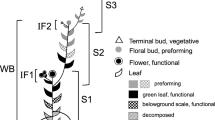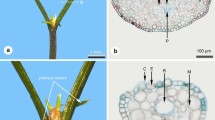Abstract
New lobe development and lobe division was studied in the foliose lichen Xanthoparmelia conspersa (Ehrh. ex. Ach.) Hale. In thalli with either the centre or margin removed, the inside edge of the perimeter, the outer edge of the reproductive centre, and fragments derived from the thallus perimeter all regenerated growing points (‘lobe primordia’) within a year. Thalli possessing isidia had the greatest ability to regenerate growing points. In reproductive thalli, there was a positive correlation between the density of new growing points and thallus size. When fragments were cut from the perimeters of mature X. conspersa thalli and glued to pieces of slate, the ratio of growing points to mature lobes increased over 54 months. Lobes within a thallus exhibited different degrees of bifurcation. In some bifurcating lobes, the point of origin of the bifurcation advanced at the same rate as the lobe tips over 4 months but in most lobes, the bifurcation point either advanced less rapidly than the lobe tips or retreated from its original location. Removing adjacent lobes had no significant effect on the radial growth of a lobe over 4 months or on the location of the bifurcation point but it increased the number of growing points. These results suggest that for X. conspersa: 1) all portions of of thalli can regenerate growing points, 2) few growing points actually develop into mature lobes, 3) individual lobes within a thallus grow and divide differently, and 4) adjacent lobes inhibit the development of growing points on their neighbours.


Similar content being viewed by others
References
Armstrong RA (1973) Seasonal growth and growth rate colony size relationships in six species of saxicolous lichens. New Phytol 72:1023–1030
Armstrong RA (1974) The descriptive ecology of saxicolous lichens in an area of South Merionethshire, Wales. J Ecol 62:33–45
Armstrong RA (1979) Growth and regeneration of lichen thalli with the central portions artificially removed. Env Exp Bot 19:175–178
Armstrong RA (1981) Field experiments on the dispersal, establishment and colonization of lichens on a slate rock surface. Env Exp Bot 21:116–120
Armstrong RA (1982) Competition between three species of Parmelia (Lichens). New Phytol 90:67–72
Armstrong RA (1984) Growth of experimentally reconstructed thalli of the lichen Parmelia conspersa. New Phytol 98:497–502
Armstrong RA (1991) Experimental studies of lobe growth in the lichen Parmelia conspersa (Ehrh. ex, Ach.)Ach. New Phytol 119:315–319
Armstrong RA (1992) A comparison of the growth curves of the foliose lichen Parmelia conspersa determined by a cross-sectional study and by direct measurement. Env Exp Bot 32:221–227
Armstrong RA (2003) Lobe connections and lobe crowding are associated with growth rate in the lichen Xanthoparmelia conspersa. Symbiosis 34:133–143
Armstrong RA, Smith SN (1992) Lobe growth variation and the maintenance of symmetry in foliose lichen thalli. Symbiosis 12:145–158
Armstrong RA, Smith SN (1997) Factors associated with degeneration of the thallus centre in foliose lichens. Symbiosis 22:293–302
Armstrong RA, Smith SN (1999) Factors associated with lobe division in the lichen Parmelia conspersa (Ehrh. ex. Ach.) Ach. Symbiosis 26:265–277
Greenhalgh GN, Anglesea D (1979) The distribution of algal cells in lichen thalli. Lichenologist 11:283–292
Hale ME (1970) Single-lobe growth rate patterns in the lichen Parmelia caperata. Bryologist 73:72–81
Hale ME (1973) Growth. In: Ahmadjian V, Hale ME (eds) The lichens. Academic, New York, pp 473–492
Hill DJ (1981) The growth of lichens with special reference to the modelling of circular thalli. Lichenologist 13:265–287
Hill DJ (1984) Studies on the growth of lichens. 1. Lobe formation and the maintenance of circularity in crustose species. Lichenologist 16:265–287
Hill DJ (1985) Changes in photobiont dimensions and numbers during co-development of lichen symbionts. In: Brown DH (ed) Lichen physiology and cell biology. Plenum, New York, pp 303–317
Hill DJ (1992) Lobe growth in lichen thalli. Symbiosis 14:325–333
Hilmo O, Ott S (2002) Juvenile development of the cyanolichen Lobaria scrobiculata and the green algal lichens Platismatia glauca and X. norvegico in a boreal Picea abies forest. Plant Biology 4:273–280
Honegger R (1995) Spatial disturbance at the organismic level and to spatial problems at the cellular level during drought stress events. Can J Bot-Revue Canadienne de Botanique 73:569–578
Honegger R (1996) Experimental studies of growth and regenerative capacity in the foliose lichen Xanthoria parietina. New Phytol 133:573–581
Honegger R, Conconi S, Kutasi V (1996) Field studies on growth and regeneration capacity in the foliose macrolichen Xanthoria parietina (Teloschistales, Ascomycotina). Bot Acta 109:187–193
Hooker DJ (1980) Lobe growth and marginal zonation in crustose lichens. Lichenologist 12:313–323
Katz D, Goldstein D, Rosenberger RF (1972) Model for branch initiation in Aspergillus nidulans based on measurements of growth parameters. J Bacteriol 109:1097–1100
Kershaw KA, Millbank JW (1970) Isidia as vegetative propagules in Peltigera apthosa var variolosa (Massal.)Thoms. Lichenologist 4214–217
Lawrey JD (1984) Biology of lichenized fungi. Praeger, New York
Stocker-Worgotten E (1991) Thallus formation of two cyanobacterial lichens: Peltigera didactyla and P. praetextata, under laboratory conditions. Bull Soc Bot France 138:179–187
Valledares F, Ascaso C, Sancho LG (1994) Intrathalline variability of some structural and physical parameters in the lichen genus Lasallia. Can J Bot–Revue Canadienne de Botanique 72:415–428
Author information
Authors and Affiliations
Corresponding author
Rights and permissions
About this article
Cite this article
Armstrong, R.A. Lobe formation and division in the foliose lichen xanthoparmelia conspersa . Symbiosis 51, 227–232 (2010). https://doi.org/10.1007/s13199-010-0075-1
Received:
Accepted:
Published:
Issue Date:
DOI: https://doi.org/10.1007/s13199-010-0075-1




